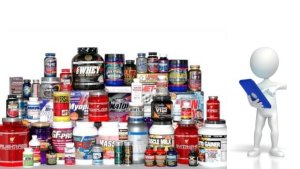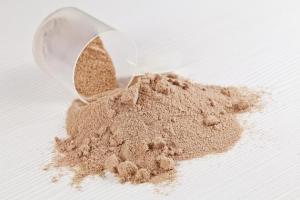We talked earlier how opting for a make your own shake is one of the easiest and quickest way to incorporate more protein at breakfast.
Today, we’d like to walk you through all the powders you might come across.
Frankly, we are firm believers in incorporating a variety of protein sources as no single source is “best” for all possible outcomes. Also, people can develop low-grade allergies to proteins if they exclusively eat/use only one type of protein in their diet.
Animal Proteins
Whey
Whey protein (one of the dairy proteins) has the highest lecuine content of any protein powder, meaning it will stimulate protein synthesis to a greater extent than do other proteins.
Concentrates
Whey concentrate is considered less “pure” and contains less protein per scoop (often containing higher amounts of carbohydrates and fat as well). That being said, it undergoes the least amount of processing of any whey protein and retains the largest number of bioactive subfractions, which have a variety of health benefits.
Due to its higher lactose content, some individuals do struggle to digest whey concentrates, so before buying a huge tub, test your individual tolerance to a particular brand. This type of protein really requires supplemental digestive enzymes.
Isolates
A pure whey protein, containing over 90% protein per scoop. Whey isolate is digested rapidly, making it a popular choice for protein powders ingested immediately post-workout.
Due to the processing techniques required (cold filtered is best), whey isolates do tend to be more expensive, however, they also produce less gastrointestinal distress than do concentrates.
Hydrolysates
Any hydrolyzed protein is digested and absorbed extremely rapidly. However, they tend to taste quite bitter and are very expensive. As a result, we don’t recommend going this route unless you absolutely can’t digest concentrates or isolates.
Blends
Typically a mix of concentrate/isolate, these proteins often offer the benefits of both types. Considering most of us aren’t elite athletes training 2-3x/day, the absolute speed of nutrient absorption is a minor concern, so we’d be better off choosing a blended whey protein.
These proteins tend to be quite affordable (~$50/5 lbs, which is 75 x 25 g servings) and can be found in a variety of flavours.
Casein
Casein (the other dairy protein) is digested very slowly. This lengthy speed of digestion makes casein a subpar choice for spiking protein synthesis, however, it does make it strongly anti-catabolic (which means it is great at preventing protein breakdown).
Casein-based powders are better choices for hunger managements and as pre-bedtime options. Cottage cheese is a natural food high in casein, whereas greek yogourt is a food higher in whey.
Several people do have dairy allergies though, particularly to casein, so if you are someone who does not tolerate dairy well, you are best to look into alternate sources.
Egg white protein
Egg white protein is one animal-sourced protein that is incredibly easy to digest, making it pretty suitable for many diets. Some people find the taste a little bland/salty though.
Pasteurized egg whites in the carton (best price is at Costco, 3 x 500 ml for under $5) are another easy way to incorporate more egg protein into your diet.
Vegetarian protein
When it comes to vegan proteins, one (minor) concern is that they are not as bio-available as animal proteins. However, given that North Americans generally eat quite a bit of protein, this isn’t a huge drawback, particularly when using them in the form of a powder.
Soy
Soy protein is the most “complete” of all vegetable proteins (meaning it contains all the essential amino acids). However, soy can exert some negative hormonal impacts in certain individuals. This suggests that we rarely would recommend using soy as your sole source of protein.
When it comes to soy-based products, we don’t recommend ingesting large amounts of refined soy products like soy protein, soy milk, soy burgers, soy cheese… etc. However, fermented soy products (tempeh, miso, some tofu and natural soy like edamame) are a valuable addition to any diet.
Pea protein
Pea protein is a fairly innocuous protein that we generally recommend ahead of soy (for the aforementioned reason). It’s inexpensive, tastes ok and isn’t overly allergenic. It’s got a nutty taste to it.
Hemp
Hemp protein is another great product. However, in contrast to the proteins listed above, it’s not a pure protein source (it contains some fat, fiber and carbs), which renders it a little less versatile for certain recipes.
Hemp does go great in oatmeal, muffins and pancakes but some people find the grittiness a turn-off when added to shakes.
Rice protein
An ok vegetable protein. It lacks a complete spectrum of amino acids and doesn’t taste all that great. But it’s low on the allergenic scale so if you’ve exhausted all your option, you can check it out.
Protein Wrap Up
All protein powders (and protein sources in general) have their pros and cons. The key is to find one that fits with your overall dietary approach (animal vs. vegetables), doesn’t provoke allergies, and fits your budget/taste preferences. For best results, try to rotate between a couple of different type, just to avoid any potential allergies.
Resources
Protein powders can be purchased pretty much anywhere these days. But occasionally, you can get really good deals shopping online. Here are some of the online distributors that routinely have good prices.
A design-your-own US protein company. A great option for all you closet chemists, although they do offer a large selection of pre-made products as well.
A company based out of BC. They’ve recently been running some killer deals on large protein orders (i.e. 20 lbs for $150) so they are worth checking out from time to time.
They have outlets all across the country. They do run deals often enough and have a pretty decent selection.
A US company. Because of the obscenely large amount of customers they have, they often boast ridiculous prices on their products, even after you factor in the exchange rate and shipping. One word of advice, since your products will be coming across the border (and will take ~10 days to arrive), pool together a few friends and put in for a larger order. It’s a hassle ordering a single product at a time.


